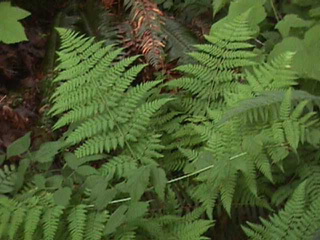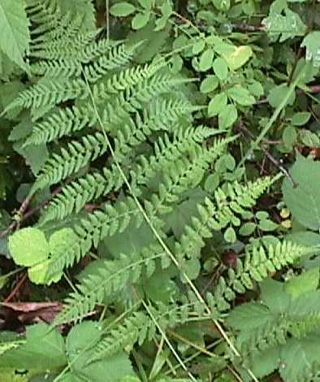

General Species Description
- Lady fern is a deciduous fern which is often found standing in vase like tufts at around .5 meters in heighth, although may grow up to 2 meters in heighth. The fronds arise from stout, ascending toerect rhizomes. The rhizomes are scaly and are observed to have old leaf stalks at their bases.
Leaves
- The ascending to erect fronds, or leaves, are pale green, very delicate, and each has 20 to 40 pairs of pinna. Each pinnae is twice pinnately compound, but can also be said to be thrice due to the toothed margins of the pinnae. The frond is lance shaped, tapering at both ends with middle being the widest point. This is often the distinguishing feature of the lady fern. Fronds unroll from fiddleheads, the curled baby leaf buds.
Inflorescence/Flowers
- Lady fern is not a flowering plant. It reproduces similar to mosses and lichens using the alternation of generations cycle. The sexual gametophtic stage is not visible to the naked eye. The nonsexual sporophytic stage is the deciduous fern with which we are familiar. The spores are found gouped in sori on the underside of the leaf.
Fruits
- The orange-brown spots on the underside of the leaf are sori, clusters of spore sacs. On the lady fern these spores are covered by a crescent to horseshoe shaped insidium. As the leaf drys spores pop off and reproduce in the moist ground below.
Habitat
- Due to the fact that ferns reproduce by spores rather than the highly protected seed,
adequate moisture must be available for reproduction. Being as such ferns are mostly
absent from drier environments. Lady fern is found in moist to wet forests, swamps,
openings, saturated soils along streambanks, and is often found dominating densely shrubed wetlands.
Range
- Lady fern is circumboreal, found from lowland to montaneregions. It is common in moist environments in California, Washington, and Oregon. In Oregon it occurs in virtually every county.
Similar Species
- Lady fern could be confused with other fern species such as spiny wood fern (Dryopteris expansa), Alpine lady fern (Athyrium distentifolium), and Oak fern (Gymnocarpium dryopteris). Spreading wood fern is ditinguished by the triangular shape of the fronds, which do not taper at the base as do those of the lady fern. Also the stem does not bear the old leaf stalks at the base as that of the lady fern, and is much less delicate. Alpine lady fern is distinguished by its heigth of only op to 80 cm, its narrower outline, and its typical location being in high elevations. Oak fern is distinguished by its triangular shape as was the spiny wood fern.
Ecological Value
- No information was found on its ecological value, although its large leaves probably provide habitat for many insects on which birds feed.
Human Value
- The Native peoples all over used the large leaves for laying out or covering food, medicine, scouring pads, decoration in baskets, and diaper linings. The fiddleheads were boiled, baked, or eaten raw in the spring. However, some species of fiddleheads have been shown to be carcinogenic and only eaten after proper research and identification.
References
- Pojar, J. and A. MacKinnon. 1994. Plants of the Pacific Northwest Coast. Lone Star Publishing, Richmond WA, 422 pp. Cooke, S.S., ed. 1997. A Field Guide to the Common Wetland Plants of Western Washington and Northwest Oregon. Seattle Audobon Society and Washington Native Plant Society. Seattle Audobon Society, Seattle WA, 371 pp.
This page was created by: Mindy Fagerstrom, August 1999
Return to Northwest Oregon Wetland Plants Project